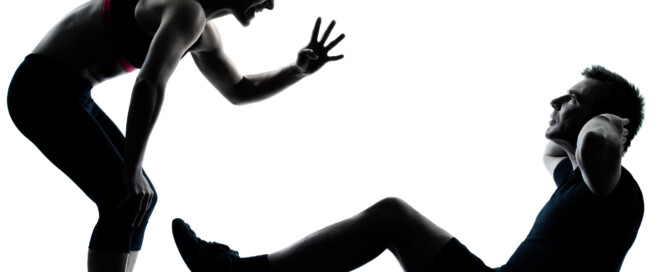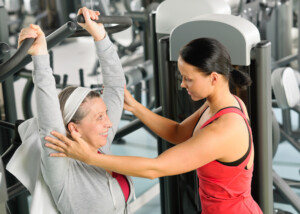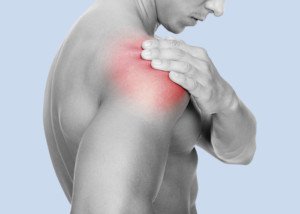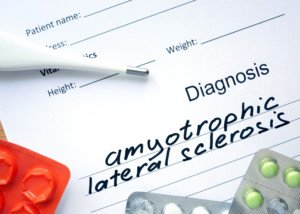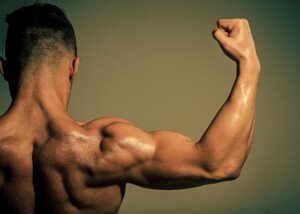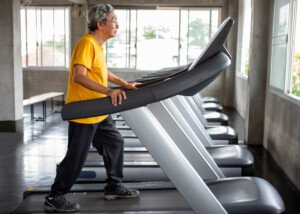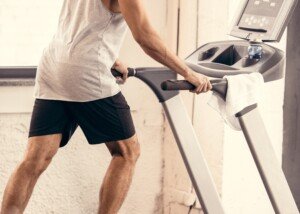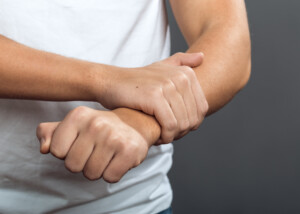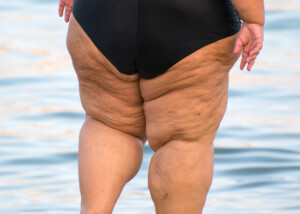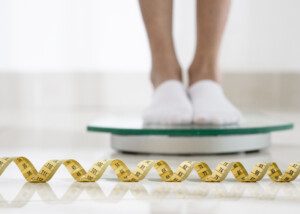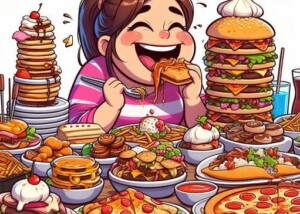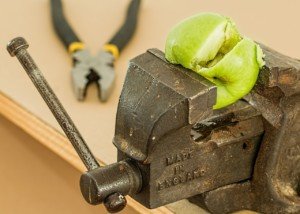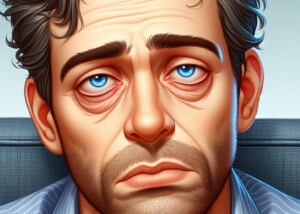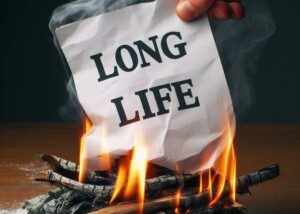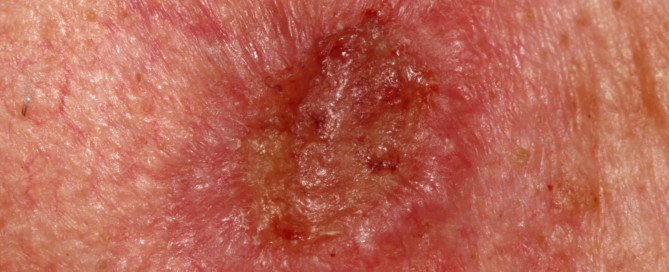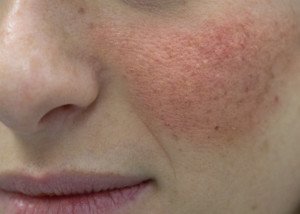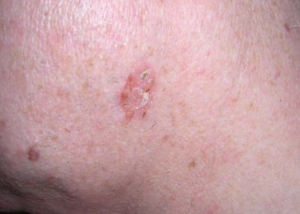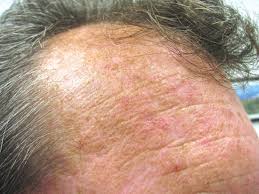Can a Man Benefit from a Female Personal Trainer?
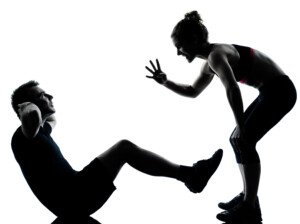
You’d better believe a man can reach his goals with a woman personal trainer; one man called me “es muy brutal,” Spanish for brutal! (more…)
Best Weight Loss Workouts for Obese or Overweight Women

Don’t give up hope; it’s a matter of working out correctly, not “fat genes.”
Let me show you how to melt the fat safely and get super fit.
When I was a personal trainer at a health club, I didn’t have my obese and overweight female clients doing the workouts that most of the other trainers had their heavy clients doing.
That’s because the other trainers were having their overweight and obese women working out wrong.
Best weight loss workouts if you’re an obese or overweight woman?
First, I’ll tell you what will fail: floor exercises.
This includes endlessly-held planks, any kind of crunching, leg raising or being on all fours, or anything in which your legs are handling a fitness ball.
These aforementioned exercises will strengthen the core, but will not trigger weight loss.
And, these floor exercises are NOT the only exercises you’re capable of doing, either.
Get off the floor mentality and start thinking differently if you want to lose weight and get fitter than you’ve ever been.
Feeling too big lately? Here are your ideal exercises.
• Deadlift
• Squat
• Kettlebell swing
• Seated chest press
• Leg press
• Standing overhead barbell press
• Squat dumbbell press to overhead press
• Lat pull-down
Deadlift. Even if you’re morbidly obese, you can do this — though you may need a modification such as starting out with a far lighter weight than what you feel you need.

Deadlift start position. Freepik
Another modification is having the plates of the barbell atop a single 45 pound plate on the floor to give the starting point a slightly higher up position. Supportive footwear is a must.
This exercise works nearly every muscle group, which means more energy is required (body fat) for post-workout recovery.
Mastering safe form is paramount, especially if you’re significantly overweight.
The deadflit will improve your fitness dramatically, since many activities of daily living are derivatives of the deadlift motion.
Squat. An obese woman may be able to perform the back squat, but if not, you can do squats with the Smith machine or against the wall using a fitness ball (and holding dumbbells as you get more fit).
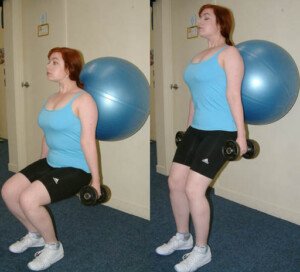
Ball wall squat. George Stepanek, CreativeCommons
Squats target the legs and butt, and these muscles burn a lot of calories.
As with the deadlift, excellent form is crucial. You’ll probably need to start out with a very light weight to help your body acclimate into proper form and technique.
Kettlebell swing. This, too, can be done despite being morbidly obese, and works many muscle groups at once.
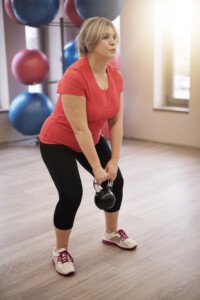
Starting position for a kettlebell swing. Shutterstock/gpointstudio
It’s important to begin with a light kettlebell. In fact, the amount of weight you should use as a beginner will feel lighter than you think you need when you pick the kettlebell off the rack.
But don’t let that fool you. Stand with feet shoulder-width apart, kettlebell on floor.
Hinge at hips, grip handle with both hands. Hike it back between legs, keep back flat.
Drive hips forward explosively to swing up to chest height.
Let momentum bring it down, repeat in a smooth rhythm. Use hips, not arms.
Seated chest press. I recommend this over the bench press for very overweight women.
That’s because if you’re pushing out from a horizontal position, your chest/stomach girth is less likely to cut short the range of motion.
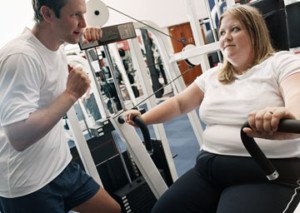
Chest press
If you bench press, the range of motion will be cut by your chest/stomach girth, and you’ll end up doing incomplete repetitions.
Leg press. As far as positioning, just about anybody can do this, though depending on the girth of your midsection, you’ll need to have your feet and knees spaced very widely apart.
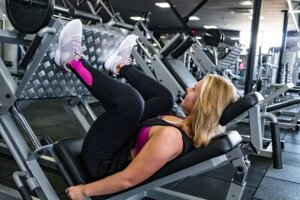
Leg press. Shutterstock/Aleksey Boyko
But wide spacing is perfectly okay, because in a real life situation where you must squat down to pick something heavy up from the ground, it’s better for your feet to be widely spaced.
Standing overhead barbell press. Morbid obesity will not impede you with this. You are on a perfectly equal playing field with a thinner woman. As you become stronger at pushing something over your head, your confidence will soar.
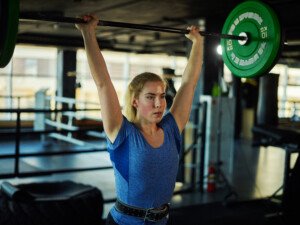
Overhead barbell press. Shutterstock/Comeback Images
Squat dumbbell press to overhead press. This is more suitable for a woman of moderately overweight proportions rather than severe obesity.
Technique should be derived from the squat and deadlift, namely, do NOT round your back or lean forward. You’ll need to start with very small dumbbells.
In fact, you should get this motion down with your body weight first before using any weights.
I recommend dumbbells heavy enough to complete 8-12 reps once you’re able to conduct this compound movement with exellent form and light dumbbells.
Take one minute rests in between. Complete four sets. Your thighs do not need to go past parallel, but aim for parallel, to the floor.
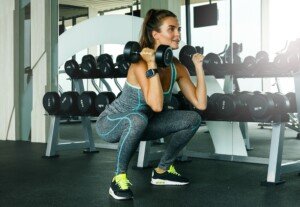
Squat to overhead press. Shutterstock/BLACKDAY
Warning: This routine can be very draining, but it’s over in about five minutes and will leave your metabolism elevated even after you’re finished, not to mention dramatically increase fitness level.
Lat pull-down. I recommend this over the seated row because chest/belly girth will not shorten the range of motion.
The weight should be heavy enough to prevent the mistake of pulling the bar below chest level and bending the forearms to parallel to the floor.
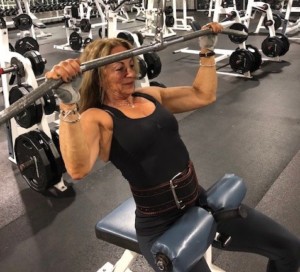
Sharon Smith, 71, demonstrates the lat pull-down.
If you’re able to bend the forearms, the resistance is WAY too light and you’re wasting your time.
Guidelines
• Do the exercises twice a week.
• Four sets each.
• If you can do more than 12 reps, the resistance is too light.
• If you can’t complete eight reps, the resistance is too heavy.
• Take one minute to 90 seconds’ rest in between specific exercises.
I can go on in more detail regarding the configuration of sets, rests, days off, muscles worked, etc., with this workout plan, but the information here is a superb starting point for overweight and obese women who have been struggling to lose weight.
Sharon Smith has been in the fitness industry for 25+ years and specializes in the over-40 client.
 Lorra Garrick is a former personal trainer certified through the American Council on Exercise. At Bally Total Fitness she trained women and men of all ages for fat loss, muscle building, fitness and improved health.
Lorra Garrick is a former personal trainer certified through the American Council on Exercise. At Bally Total Fitness she trained women and men of all ages for fat loss, muscle building, fitness and improved health.
.
Top image: Shutterstock/ YAKOBCHUK VIACHESLAV
Second image: Shutterstock/SerdyukPhotography
Are Your Muscles Twitching Head to Toe?

Perhaps your muscle twitching started in one spot and then “spread” so that it’s now all over your body and you’re fearing the worst—like ALS?
Yes, muscle twitching is listed on medical sites like webmd.com as a possible symptom of ALS. (more…)
Is Your Cardiologist a Personal Trainer? How to Use a Treadmill
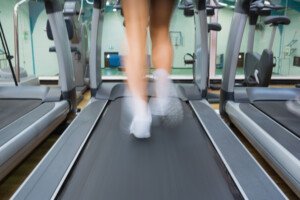
It’s cardiologist vs. personal trainer when it comes to how to properly use a treadmill and aerobic exercise in general.
Who wins?
I pointed out to a personal-training client that holding onto a treadmill was a bad habit that disrupted natural gait and did not simulate natural walking.
Her response? “Are you a cardiologist?” She then said her cardiologist told her to walk that way.
I’m not a cardiologist, but my knowledge of exercise science is sufficient for me to know that clutching the front bar of a treadmill also disrupts optimal breathing, can raise blood pressure and also lead to repetitive stress injuries in the hips, which are forced to over-rotate.
My mother years ago underwent multiple bypass surgery.
Her heart surgeon told her that the only exercise she ever needs is to just walk 40 minutes every day.
The patient pre-surgery was sedentary; did no exercise.
Post-surgery, she hears from her surgeon, “Walk 40 minutes a day. That’s all the heart needs.”
Because my mother frequently went shopping and lived in a big house at the time, and did all the housework, she convinced herself that this walking recommendation was automatically built into her day-to-day life!
Hence, she never committed to any 40 minute walking sessions.
The cardiothoracic surgeon’s exercise recommendation was too close to that of baseline living!
It’s one thing to suggest starting out with a 40 minute walk.
But to present this as the be-all, end-all, encourages patients to make no changes in their physical activity levels.
They may think, “I don’t have to go on 40 minute walks; I do plenty of walking every day on the job!”
At a minimum, not a maximum, you should get sustained aerobic exercise several times a week.
A treadmill is a good place to start.
How to Properly Use a Treadmill
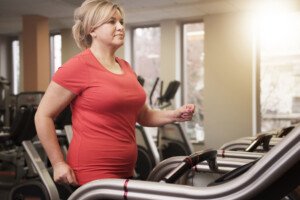
Right! Shutterstock/gpointstudio
Unless you have a mobility impairment, there is no need to hold on — other than for momentary balance checks or steadiness while changing the settings, drinking a beverage, turning to greet someone and getting a heart rate.
A cardiologist may tell you to hold on to protect himself or herself from being blamed in case the patient falls off the treadmill and breaks an arm after being told by the cardioloist they should swing their arms.
But ask yourself this: How is the human body designed to walk?
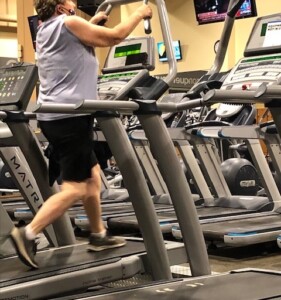
Wrong!
How old were you when you began walking without clinging onto anything?
If you do not hold onto a treadmill, your body will be forced to balance all on its own, with no external help, and to assume correct posture.
Your balance will improve. You’ll burn more calories (the calorie display doesn’t change whether you’re holding on or not).
Holding onto a treadmill will train your body to use a walker. Do you want that?
 Lorra Garrick has been covering medical, fitness and cybersecurity topics for many years, having written thousands of articles for print magazines and websites, including as a ghostwriter. She’s also a former ACE-certified personal trainer.
Lorra Garrick has been covering medical, fitness and cybersecurity topics for many years, having written thousands of articles for print magazines and websites, including as a ghostwriter. She’s also a former ACE-certified personal trainer.
.
Top image: Shutterstock/wavebreakmedia
Sources:
sciencedaily.com/releases/2011/08/110829070507.htm
sciencedaily.com/releases/2008/06/080604101529.htm
sciencedaily.com/releases/2011/04/110405194101.htm
Exercise for Parkinson’s: Low Intensity vs High Intensity

If you have Parkinson’s disease, you’ll be interested in a study that looked at low intensity and high intensity exercise for people with this condition.
Can Obesity Cause Joint Injuries from Strength Training?

Are you very plus size and wondering if lifting weights can harm your joints, due to your obesity?
There are various exercises that plus size women and men do that are more threatening than lifting weights. (more…)
The Advantages of Doing HIIT on a Treadmill vs. Other Machines
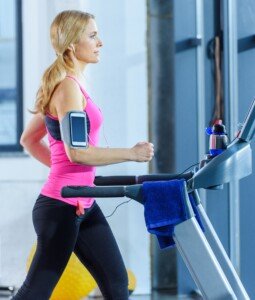
Ready for some HIIT? Okay, but which type of cardio equipment is best?
There are many things to consider like impact, comfort and boredom! I vote for the treadmill.
If you dread a particular piece of cardio equipment–and many don’t care for the treadmill, then it isn’t the best kind for high intensity interval training for you because you’ll never push yourself as hard on it as you will on the cardio machine that you like much better. (more…)
Why Intuitive Eating Promotes Overeating that Prevents Weight Loss

“Intuitive eating” is an approach pushed by the health-at-all-sizes movement, but this flawed approach can really make you gain unhealthy fat weight.
If you’ve taken any pledges or have simply visited a website that promotes the so-called intuitive eating approach, you may now be wondering if this is your calling.
Though some elements of this approach make sense, such as don’t eat past the point of satiation, and don’t eat for emotional reasons, it leaves the door open for overeating, because “Eat when you are hungry” (one of the tenets) could spell trouble for many people.
Today’s sedentary lifestyle and processed foods are making people hungrier than ever.
“We live in a ‘manufactured’ food environment,” says Richard Kelley, MD, a practicing physician in Texas for 20+ years, and author of “The Fitness Response,” “The Three-Hour Appetite” and the ebook, “The Fitness Response ‘Diet’ for Women.”
Dr. Kelley says nearly 70 percent of Americans are overweight or obese. “Many of these individuals are eating intuitively.
“Intuitive eating in the food environment, in which we live, just doesn’t help most people stay at a healthy weight.”

Freepik.com, wayhomestudio
The approach to weight loss should be integrated with fitness. “The most successful individuals among us, where losing weight is concerned, don’t just eat intuitively,” says Dr. Kelley.
“These individuals know and understand the macronutrients that comprise the components of food, and they eat in a very consistent and strategic manner, to maintain their weight and develop the physical bodies that most of us would associate with being ‘fit’ or in great shape.”
The main macronutrients are protein, carbohydrates and fats, such as chicken, pasta and peanut butter, respectively.
“I believe this is just one of the areas where people struggling with their weight, simply miss the mark,” continues Dr. Kelley.
“They have little understanding of how the food they eat really affects their bodies.
“Consequently, the idea that intuitive eating leads people to a healthy weight, is a nice philosophical stance; however, in my opinion it is a stance that is unsupported in reality.”
Eating is one part of the weight loss equation. The other part is exercise, and I don’t just mean “movement.”
The movement needs to include intense strength training and cardio if you want permanent weight loss while enjoying your favorite foods and not having to stick to unrealistic rules like avoiding eating at night.
Don’t let the catchy term “intuitive eating” throw you off course. Becoming a slave to this approach can result in polishing off a plate of donuts.

Freepik.com, sergeycauselove
 Richard Kelley, MD, is an author, speaker, fitness expert and transformation coach.
Richard Kelley, MD, is an author, speaker, fitness expert and transformation coach.
 Lorra Garrick has been covering medical, fitness and cybersecurity topics for many years, having written thousands of articles for print magazines and websites, including as a ghostwriter. She’s also a former ACE-certified personal trainer.
Lorra Garrick has been covering medical, fitness and cybersecurity topics for many years, having written thousands of articles for print magazines and websites, including as a ghostwriter. She’s also a former ACE-certified personal trainer.
.
Top image: Viktoriia Hnatiuk
Simple Signs Your Child Was Misdiagnosed with ADHD
There are clear signs that indicate your child was misdiagnosed with ADHD.
ADHD is an acronym that describes a large group of features in an individual.
There is no diagnostic test known that definitively confirms that a child (or adult) actually has attention deficit hyperactivity disorder, which is a lifelong neurodevelopmental condition. (more…)
Squamous Cell Carcinoma Skin Cancer Questions Answered
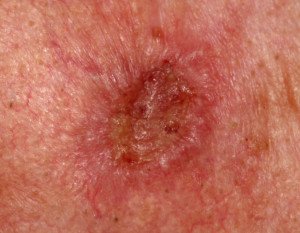
What is squamous cell carcinoma? It’s the second deadliest skin cancer.
Squamous cell carcinoma, which is directly tied to sun exposure, kills about 3,500 Americans yearly. (more…)

